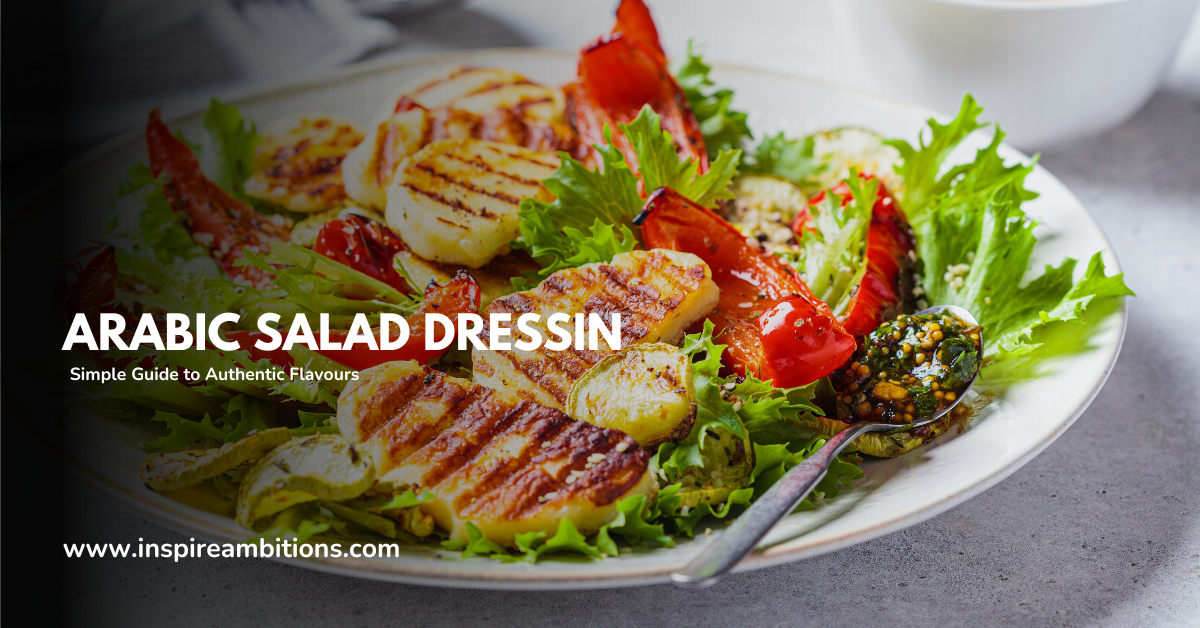अरबी सलाद ड्रेसिंग - प्रामाणिक स्वादों के लिए एक सरल मार्गदर्शिका
Arabic salad dressing adds a delightful zing to any salad, with its distinct combination of flavours. Originating from the Middle East, these dressings often consist of simple yet flavourful ingredients such as sumac, pomegranate molasses, dried mint, and extra virgin olive oil. Enhanced by a perfect balance of acidity and sweetness, these dressings truly make your salads sing.
The versatility of Arabic salad dressings allows for many variations and adaptations to suit your taste preferences. A classic base often includes lemon juice, garlic, and olive oil, but adding a hint of Za’atar or other regional spices can elevate your dressing to a new level of complexity.
Whether you’re dressing a traditional Fattoush salad, loaded with cucumber, parsley, and mint or simply drizzling over a light lettuce and tomato salad, an Arabic dressing can be the star of the dish.
Incorporating an Arabic salad dressing into your meals not only introduces a burst of flavour but also offers numerous health benefits. Ingredients like garlic, parsley, and olive oil are known for their antioxidant and anti-inflammatory properties, supporting overall well-being.
So, as you mix up your next Arabic-inspired dressing, know that you’re choosing a tasty and nutritious way to dress your salads.
Understanding Arabic Salad Dressing
आइए इसका अन्वेषण करें।
Origins of Arabic Salad Dressing
Arabic salad dressing is rooted in the traditional culinary practices of the Middle East, where it has been used for centuries to flavour and complete various salads and dishes. This versatile dressing not only enhances the taste of the ingredients but also contributes to the overall experience of enjoying अरबी व्यंजन.
Key Ingredients of Arabic Salad Dressing
The ingredients in Arabic salad dressing may vary from one version to another, but some essential components give it its unique flavour:
- नींबू का रस: Freshly squeezed lemon juice adds a refreshing tanginess to the dressing, balancing the richness of other ingredients, such as olive oil.
- जैतून का तेल: A staple in Middle Eastern cooking, olive oil combines well with lemon juice to create a smooth, velvety consistency. It also allows the flavours of the other ingredients to mix and blend harmoniously.
- Parsley and mint: These herbs lend their fresh and fragrant characteristics to the dressing, giving it a light and invigorating touch.
- एक प्रकार का पौधा: Made from dried and crushed sumac berries, this reddish-purple powder adds a citrusy and tangy flavour, similar to lemon but less tart. Sumac is a popular seasoning in Middle Eastern cuisine, giving dishes their distinct, zesty taste.
- Pomegranate molasses: Characterised by its tangy sweetness, pomegranate molasses adds a unique depth of flavour to the dressing. As it is quite concentrated, a small amount goes a long way in enhancing the taste of your salad.
These ingredients can be combined in different proportions to create variations of Arabic salad dressing, giving you the freedom to experiment and find the perfect balance for your taste buds.
Types of Arabic Salad Dressing
Arabic salad dressing varies depending on the region and the specific salad it is accompanying. In this section, we will explore three popular types of Arabic salad dressing: Lebanese, Egyptian, and Moroccan.
Lebanese Salad Dressing
Lebanese salad dressing is known for its tangy and slightly sweet flavour, achieved through the use of pomegranate molasses. In addition to pomegranate molasses, this dressing also features ingredients such as olive oil, lemon juice, and sumac, which complement the fresh flavours of various salads.
The dressing can be easily prepared by shaking up the ingredients in a jar, allowing you to adjust the proportions to suit your taste.
A traditional Lebanese salad that pairs well with this dressing is Fattoush, but the dressing can also be used with other salads like Tomato Cucumber Salad, Lebanese Couscous Salad or Malfouf Salad.
Egyptian Salad Dressing
Egyptian salad dressing is a simple yet delicious addition to salads featuring tomatoes, cucumbers, onions, and other vegetables. It is typically made from a blend of lemon juice, vinegar, olive oil, and garlic, with a hint of cumin to add depth to the flavour.
This dressing is the perfect match for an Egyptian-style chopped salad, known as Salatat Baladi. To make this dressing, simply whisk together the ingredients in a small bowl, then pour over your salad and toss to combine. The balance of tangy lemon and vinegar, along with the subtle spice of cumin, makes this dressing an essential component of Egyptian cuisine.
Moroccan Salad Dressing
Moroccan salad dressing is a fragrant blend of spices and flavours that reflects the rich culinary traditions of Morocco. This dressing commonly includes ingredients like lemon juice, olive oil, cumin, paprika, and occasionally a touch of honey for sweetness. Moroccan salads often feature a combination of cooked and raw vegetables, which are perfectly complemented by this flavourful dressing.
To make Moroccan salad dressing, combine the ingredients in a jar, then shake until emulsified. Pour over your salad, such as a Moroccan Carrot and Orange Salad or Spicy Chopped Salad, to add a burst of North African flavour to your meal.
Creating Your Arabic Salad Dressing
Let’s create it now.
तैयारी युक्तियाँ
Before creating your Arabic salad dressing, gather fresh ingredients to ensure maximum flavour. Typical ingredients you’ll need include lemon juice, olive oil, garlic, pomegranate molasses, sumac, and dried mint1. You may also want to include za’atar2 or adjust the ingredients to your taste.
To make the dressing, simply whisk or shake the ingredients together in a jar, ensuring they are well mixed. You can adapt the quantities of each ingredient to suit your preferences. For example, increasing the lemon juice will result in a tangier dressing, while adding more pomegranate molasses will make it sweeter1.
A key aspect to remember when making an Arabic salad dressing is to keep it simple. This allows the fresh and vibrant flavours of the herbs and spices to shine through. So, focus on using high-quality ingredients and resist the temptation to overcomplicate the recipe.
Storage Tips
Storing your homemade Arabic salad dressing correctly will help maintain its freshness and flavour. To do this, pour the dressing into an airtight container or a jar with a tight-fitting lid. This will prevent the dressing from being exposed to air, which can cause the herbs and other ingredients to lose their potency.
Keep the container in the refrigerator, where it will stay fresh for 1-2 weeks3. It’s important not to keep the dressing at room temperature, as the quality will deteriorate more rapidly, and there’s a risk of bacterial growth.
Before using your stored dressing, give the container a good shake to recombine any ingredients that may have separated. This ensures a consistent flavour throughout your salad.
In short, creating your Arabic salad dressing involves selecting fresh, quality ingredients and keeping their flavours simple yet bold. Store the dressing correctly, and you’ll have a delicious, homemade addition to your salads for the weeks to come.
Nutritional Benefits of Arabic Salad Dressing
Arabic salad dressing is typically made with a combination of freshly squeezed lemon juice and olive oil, sometimes enhanced with other flavourful ingredients like garlic or pomegranate molasses. This type of dressing offers several health benefits while also adding a burst of flavour to your salad.
The lemon juice in the dressing is a rich source of vitamin C, which is an essential vitamin that supports your immune system, helps with collagen production, and aids in the absorption of iron. Vitamin C also acts as a powerful antioxidant, protecting your body from the damaging effects of free radicals.
जैतून का तेल is a star ingredient in Arabic salad dressing, providing a wealth of health benefits. It is particularly high in heart-healthy monounsaturated fats and contains a good amount of antioxidants, vitamins E and K, and various anti-inflammatory compounds.
- Monounsaturated fats can help lower your risk of heart disease by reducing levels of harmful LDL cholesterol while maintaining or even raising levels of beneficial HDL cholesterol.
- Antioxidants in olive oil, such as oleocanthal and oleuropein, help to protect your body from oxidative stress and inflammation.
- विटामिन ई contributes to the maintenance of healthy skin, strong immune function, and balanced blood clotting.
- विटामिन K supports proper bone health and blood clotting.
Using Arabic salad dressing in moderation can be a simple and delicious way to incorporate these essential nutrients into your diet. Just be mindful of the sodium content in the dressing, aiming for around 250 mg or less per serving, as high sodium intake is linked to strokes, cardiovascular disease, and high blood pressure. By selecting low-sodium options or preparing your dressing at home, you can easily make healthier choices and enjoy all the nutritional benefits that Arabic salad dressing has to offer.
Pairing Arabic Salad Dressing with Foods
When choosing foods to pair with your Arabic salad dressing, consider the vibrant and fresh flavours that complement each other. The acidity and herbs in the dressing bring out the best in a variety of dishes, creating a well-balanced meal.
To start, pair Arabic salad dressing with traditional salads like Fattoush, which features lettuce, tomatoes, cucumber, onions, parsley and mint. The zesty dressing elevates the fresh and crunchy ingredients, making it a popular choice for a light lunch or a side dish alongside grilled meat.
Speaking of grilled meat, Arabic salad dressing is a fantastic accompaniment to protein dishes such as grilled chicken, lamb or fish. The tangy and herbaceous dressing cuts through rich flavours and provides a refreshing contrast to savoury options. This combination is especially inviting during summer barbecues and alfresco dining experiences.
Beyond meat, Arabic salad dressing finds its place in numerous vegetarian and vegan dishes. For example, it pairs particularly well with roasted vegetables like aubergine, courgettes and peppers, adding a new depth of flavour to these earthy ingredients. You may also use the dressing as a dipping sauce for falafel or as a drizzle for your favourite grain bowls and tabbouleh.
Last but not least, don’t forget to incorporate Arabic salad dressing into your mezze or tapas-style spreads. A collection of small dishes, including dips like hummus, baba ghanoush and labneh, benefit from a generous drizzle of the zesty dressing. Additionally, the dressing’s bright flavours complement marinated olives, stuffed vine leaves, and a variety of flatbreads, ensuring a true taste sensation for you and your guests.
In short, pairing Arabic salad dressing with foods is all about exploring the delicious harmony that results from combining fresh flavours and contrasting textures. Experiment with various dishes and enjoy the mouth-watering symphony created by this versatile dressing.
Common Mistakes When Making Arabic Salad Dressing
Overusing oil:
One common mistake when making Arabic salad dressing is using too much oil. It’s crucial to achieve a balance between the oil and other ingredients like lemon or vinegar to ensure a light and refreshing taste. Aim for a 2:1 ratio of oil to lemon or vinegar.
Skipping garlic:
Garlic is an essential ingredient in Arabic salad dressings, as it brings a pleasant punch to the overall flavour. Not including garlic or not using enough can leave your dressing lacking in depth and complexity. Generally, one or two crushed cloves will do the trick.
Not seasoning properly:
Another mistake is not adequately seasoning the dressing. While it’s essential to avoid over-salting, under-seasoning can lead to a dull, flavourless dressing that doesn’t enhance your salad. Use a pinch of salt and pepper, and taste as you go to find the perfect balance.
Overlooking the za’atar:
Za’atar is a Middle Eastern spice blend that adds a unique and delicious flavour to your Arabic salad dressing. Not everyone is familiar with za’atar, but skipping this ingredient can result in an authentic taste that doesn’t quite hit the mark.
Not whisking enough:
Finally, don’t forget to whisk your dressing thoroughly. Mixing the ingredients well ensures a proper emulsion of oil and vinegar or lemon juice, giving your dressing the ideal consistency and flavour distribution. Spend a few extra moments whisking to avoid a separated or uneven dressing.
By avoiding these common mistakes, you can create a perfect Arabic salad dressing that will elevate your salad and अपनी स्वाद कलिकाओं को प्रसन्न करें.
Frequently Asked Questions About Arabic Salad Dressing
What are the typical ingredients in an Arabic salad dressing?
Typically, an Arabic salad dressing consists of olive oil, lemon juice, garlic, salt, and various spices such as sumac, cumin, or dried mint. You can also find variations that include pomegranate molasses or red wine vinegar for added flavour.
How do I prepare the dressing?
To prepare the dressing, simply whisk or shake all the ingredients together in a small bowl or mason jar. This helps combine the ingredients and ensures a consistent flavour throughout. Remember to taste and adjust seasonings to your preference.
Can I store any leftover salad dressing?
Yes, you can store leftover dressing in an airtight container, such as a mason jar, in the fridge for up to one week. It is best to give the container a good shake before using, as the ingredients may have separated during storage.
What salads work well with Arabic salad dressing?
Arabic salad dressing pairs well with a variety of salads, from traditional Arabic salads like Fattoush and Tabbouleh to more general mixed salads including lettuce, tomatoes, cucumbers, onions, and parsley. The vibrant flavours in the dressing complement the freshness of the vegetables and herbs in these salads.
Can I adjust the flavour to my taste?
Absolutely! Feel free to experiment with the ingredients and quantities to create a dressing that suits your taste preferences. You can add more lemon juice for a tangier flavour, or increase the amount of spices for a bolder taste. Additionally, you could incorporate fresh herbs like basil or cilantro for added depth and flavour.
फुटनोट
- Hungry Paprikas. Arabic Salad with Simple Dressing. Retrieved from https://www.hungrypaprikas.com/arabic-salad/ ↩ ↩2
- Foodie With Family. Best Middle Eastern Salad Dressing. Retrieved from https://www.foodiewithfamily.com/middle-eastern-salad-dressing/ ↩
- Maureen Abood. The Ultimate Lebanese Salad Dressing. Retrieved from https://www.maureenabood.com/lebanese-salad-dressing/ ↩







